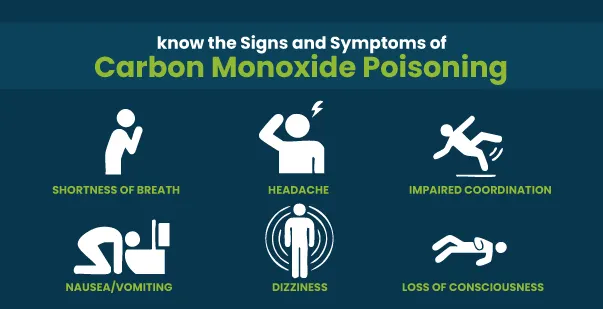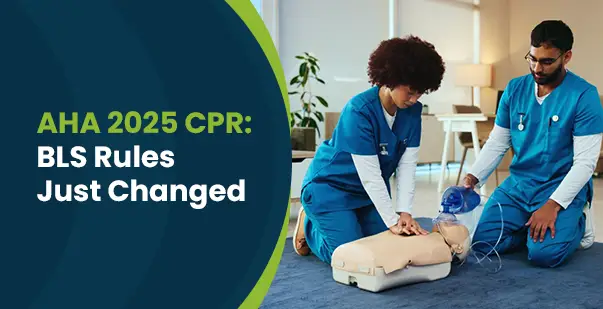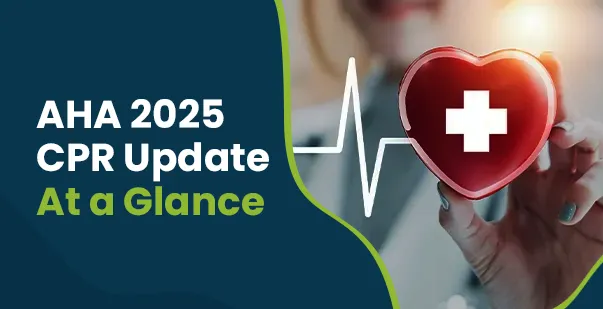Carbon monoxide poisoning is a serious condition that can happen without warning. This invisible, tasteless, and odorless gas can be deadly if inhaled in large amounts. Carbon monoxide poisoning symptoms often appear suddenly and include headaches, dizziness, nausea, confusion, and in severe cases, unconsciousness. Carbon monoxide is produced when fuels like gas, wood, coal, or oil burn incompletely. Common sources include malfunctioning heaters, car exhausts, or poorly ventilated stoves. Breathing in too much carbon monoxide stops oxygen from reaching our organs, which can be deadly causing serious harm or even death. So, keep reading to learn about the key details of carbon monoxide poisoning, its symptoms, causes, and ways to prevent exposure.
What Carbon Monoxide Poisoning Symptoms Should I Watch For?
The symptoms of carbon monoxide poisoning depend on how much gas is inhaled and for how long. Once inhaled, carbon monoxide enters the bloodstream. It binds to hemoglobin hemoglobin, the protein molecule in blood that carries oxygen, and creates carboxyhemoglobin (COHgb). This blocks oxygen from reaching the body’s cells. Without oxygen, cells and organs cannot function properly. Some of the early and advanced carbon monoxide poisoning symptoms are discussed as follows:
Headache
A mild, dull headache is one of the first signs of carbon monoxide poisoning exposure. The pain may feel persistent and doesn’t go away with rest. This happens because carbon monoxide reduces the oxygen in your blood, affecting the brain. However, headaches caused by CO poisoning are typically constant and dull, making them different from regular headaches.
Dizziness
Feeling lightheaded or off-balance is an early sign of carbon monoxide poisoning. It can happen suddenly and may worsen if you stay in the affected area. This makes walking, standing, or even staying upright unsafe. CO poisoning can also replicate alcohol intoxication. For these reasons, many individuals don’t realize they have CO poisoning at times.
Nausea
Many people experience nausea when exposed to carbon monoxide, often accompanied by a general sense of unease. This discomfort can sometimes be mistaken for food poisoning or a stomach bug. Vomiting is also a common symptom.
Fatigue
Carbon monoxide can make you feel unusually tired or weak. Your body isn’t getting enough oxygen, so even simple tasks like walking or talking might feel exhausting. This extreme fatigue can appear suddenly and worsen over time.
Confusion
Exposure to high levels of carbon monoxide can affect your brain. You may feel confused, disoriented, or unable to think clearly. It could make it hard to focus, remember things, or even understand where you are. Confusion can also make individuals act strangely. They might not recognize where exactly they are.
Chest Pain
People with heart issues may experience chest pain during carbon monoxide (CO) poisoning because the heart struggles to pump oxygen-deprived blood. This pain can feel sharp, heavy, or like pressure in the chest, signaling distress. In some cases, chest pain from CO poisoning can mimic the symptoms of a heart attack.
Shortness of Breath
Breathing may become difficult as your body struggles to get the oxygen it needs. You might feel like you are gasping for air or unable to take deep breaths. You may even panic as you feel out of breath.
Loss of Consciousness
If carbon monoxide exposure continues, you may faint or lose consciousness entirely. This happens because the body is starved of oxygen. Without timely medical help, it can lead to a coma or even death.
Vertigo
Vertigo is a spinning sensation that makes you feel off balance, like the room is moving around you. It can be triggered by carbon monoxide poisoning, as the lack of oxygen affects the inner ear and brain, causing disorientation and dizziness.
Heart Rate Changes (Tachycardia or Bradycardia)
Carbon monoxide poisoning can make your heart beat faster (tachycardia) or slower (bradycardia). This happens because your heart works harder to pump oxygen-deprived blood. A racing or sluggish heartbeat can make you feel weak, dizzy, or faint.
Stroke
In severe cases, carbon monoxide poisoning can lead to a stroke. This occurs when reduced oxygen levels disrupt blood flow to the brain. Symptoms may include sudden weakness, difficulty speaking, blurred vision, or numbness on one side of the body. Although this case might be rare, it might occur during CO poisoning, particularly during extreme cases.
Seizures
Prolonged exposure to high levels of carbon monoxide can trigger seizures. These occur because the brain isn’t getting enough oxygen to function properly. Seizures may involve sudden jerking movements, loss of consciousness, or confusion after the episode. These cases are not very common, but that doesn’t mean it won’t occur. Seizures mostly take place during long-term exposure to CO.
Muscle Spasms
In some cases, carbon monoxide exposure can cause involuntary muscle contractions or spasms. This is due to reduced oxygen flow to muscles and nerves can lead to sudden, painful cramps or stiffness in the body.
Read More: Paradoxical Breathing: Symptoms, Causes, and Treatments
6 Common Causes of Carbon Monoxide Poisoning
Did you know that the global cumulative incidence of carbon monoxide poisoning is estimated at 137 cases per million, with a mortality rate of 4.6 deaths per million? It is not a point of concern if carbon monoxide forms in the open space. However, in enclosed areas, the gas can cause huge harm. The best approach is to identify the causes of carbon monoxide formation and prevent them. Some of the most common causes of carbon monoxide poisoning are discussed as follows:
- Faulty Appliances
Appliances like gas stoves, water heaters, or boilers can release carbon monoxide if they are broken or poorly maintained. Cracks in chimneys or exhaust flues can also let this gas leak into your home. Thus, regular servicing of appliances and proper installation are necessary to prevent these leaks.
- Poor Ventilation
Carbon monoxide builds up in homes with poor airflow. This is common when windows and vents are blocked or when spaces are tightly sealed. Without fresh air, even small sources of CO can accumulate to dangerous levels. Proper ventilation ensures that gases can escape safely.
- Car Exhaust
Running a car engine in a confined area, like a garage, produces high levels of carbon monoxide. The gas can also enter the car cabin if the exhaust system is damaged. Leaving the car engine on in enclosed spaces or poorly ventilated areas can quickly become life-threatening. Modern vehicles with keyless ignitions pose an even higher risk, as drivers may sometimes forget to turn them off when parked in a garage.
- Burning Fuels Indoors
Burning fuels such as wood, coal, or charcoal inside a home can create carbon monoxide. Devices like charcoal grills, kerosene lamps, or camp stoves should never be used indoors. Enclosed spaces make it harder for the gas to disperse, increasing the risk of poisoning.
- Fires
House fires produce large amounts of carbon monoxide and smoke. Breathing in smoke during a fire can expose a person to dangerous levels of this gas. Firefighters and individuals near fires are at higher risk, especially in enclosed or poorly ventilated spaces. CO poisoning is also the primary cause of death during house fires. At times, it happens before the flames reach the victims.
- Smoking Hookah
Hookah pipes burn charcoal to heat the tobacco, releasing carbon monoxide into the air. Smoking hookah in enclosed or poorly ventilated rooms raises the risk of inhaling this toxic gas. Long sessions of hookah smoking can expose people to significant levels of carbon monoxide. Smoking Hookah indoors, particularly in poorly ventilated and smaller spaces, is dangerous.
Read More: How to Manage a Respiratory Arrest?
How Can You Prevent Carbon Monoxide Poisoning?
Carbon monoxide is often called the “silent killer” because you can’t see, smell, or taste it. When this deadly gas builds up in your home, it can cause symptoms ranging from mild headaches to fatal poisoning. Therefore, you should take some necessary steps to avoid exposure to this gas, which are discussed below:
Install Carbon Monoxide Alarms
Carbon monoxide alarms are important for detecting this harmful gas. Install them in key areas of your home, such as hallways near bedrooms and in the living area. Test alarms regularly to ensure they are working. Replace batteries every six months or when the alarm indicates a low battery. You should also use these alarms on every floor, particularly near washrooms. Be sure to replace them every five to seven years.
Maintain Appliances
Gas-powered appliances, boilers, and heaters should be inspected by a professional every year. Regular maintenance ensures these appliances are working properly and safely. Any issues, such as leaks or blockages, should be fixed immediately. Well-maintained appliances are less likely to produce carbon monoxide, reducing the risk of poisoning.
Ensure Proper Ventilation
Proper ventilation is key to preventing carbon monoxide buildup. When using fuel-burning appliances, open windows or use fans to keep the air circulating. Make sure vents and chimneys are clear of debris. Proper airflow helps prevent carbon monoxide from accumulating indoors, reducing the chances of exposure. When cooking with a gas stove within a closed room, it leads to CO buildup. This can happen even when other appliances are not running.
Avoid Running Engines Indoors
Never run a car engine, generator, or other fuel-powered devices inside a garage or any enclosed space. Even with the door open, the gas can build up quickly and cause poisoning. Always run these engines outdoors, in an open area, away from windows and doors, to ensure proper ventilation and reduce the risk of exposure. CO poisoning can also occur on boats when the engines run in enclosed cabins.
Use Devices Properly
Always follow the manufacturer’s instructions when using any fuel-burning appliances or devices. This includes stoves, grills, and heaters. Never use outdoor equipment indoors. These appliances release carbon monoxide, and using them incorrectly can lead to dangerous gas buildup. Proper use helps ensure your safety and reduces the risk of poisoning.
What to Do in Case of Carbon Monoxide Exposure
Each year, over 400 Americans lose their lives to accidental carbon monoxide poisoning. Thus, knowing what to do is important, as acting fast can save lives. Below are detailed steps to follow if you suspect carbon monoxide poisoning:
Leave the Area Immediately
The first thing to do is leave the area where the gas is present. Carbon monoxide builds up in enclosed spaces, like rooms or cars, making it dangerous to stay inside. Fresh air helps reduce the amount of carbon monoxide in your body. Move outdoors or to a place where you can breathe clean air. You also should avoid switching on the electrical appliances or the lights.
Call Emergency Services
Once you are in a safe place, call for emergency help. Dial your local emergency number to report the exposure. Tell them how many people might be affected and describe the symptoms. Acting quickly allows medical professionals to prepare the right treatment and potentially save lives. If anyone is unconscious, be sure to inform the responders right away, as this will affect their immediate response and medical approach.
Seek Medical Attention
Even if symptoms seem mild, get checked by a doctor immediately. Carbon monoxide poisoning can worsen without warning. Common symptoms include headaches, dizziness, nausea, and confusion. Medical staff will test your blood to check the levels of carbon monoxide and decide the best treatment for you.
Understand Oxygen Therapy
Doctors often use oxygen therapy to treat carbon monoxide poisoning. You will breathe pure oxygen through a mask, which helps remove carbon monoxide from your blood.
In severe cases, doctors may use hyperbaric oxygen therapy. This treatment involves breathing oxygen under high pressure in a special chamber. It works faster to reduce carbon monoxide levels. In mild cases, people should try breathing fresh air outdoors. It will certainly help.
Prevent Future Exposure
After treatment, take steps to prevent future exposure. Instal and check carbon monoxide detectors in your home regularly. Never use gas-powered devices, like generators or grills, indoors. Ensure proper ventilation when using appliances that burn fuel. These precautions can protect you and your family.
What Are The Long-Term Effects of Carbon Monoxide Poisoning?
You might wonder, what does carbon monoxide smell like? The truth is that carbon monoxide has no smell at all, so it’s important to have alarms in place and know what to do in case of exposure. Even after treatment and recovery, the effects of CO poisoning can last for a long time. Such effects can impact both physical and mental health. Below are the long-term effects of carbon monoxide poisoning:
Memory Loss
Carbon monoxide (CO) can harm the brain, potentially leading to memory loss and difficulty recalling recent or past events. The oxygen deprivation caused by CO exposure can damage brain regions responsible for storing and retrieving information. Even after recovering from CO poisoning, individuals may struggle with daily tasks that require good memory, such as managing schedules or remembering conversations. Additionally, CO poisoning can result in delayed neurological effects that appear weeks or even months after exposure.
Difficulty Concentrating
Another common issue is trouble focusing or thinking clearly. Damage to the brain caused by CO poisoning can make it harder to stay attentive for long periods. People may feel distracted or confused, even during simple activities like reading or having a conversation. This can make it difficult to work, study, or manage everyday life.
Mood Changes
Carbon monoxide poisoning can affect emotions. Many people experience mood swings, irritability, or feelings of depression after recovery. These changes happen because CO can disrupt the normal functioning of the brain’s emotional control systems. For some, these mood issues may last for months or even years, making it important to seek mental health support when needed.
Damage to the Heart
Carbon monoxide does not only affect the brain; it can also harm the heart. Long-term exposure or severe poisoning can weaken the heart muscle. This may lead to conditions like heart failure or irregular heartbeats. Reduced oxygen flow during the poisoning can cause permanent damage, increasing the risk of heart problems in the future. Individuals who have heart ailments are also at a much higher risk.
Damage to the Brain
Serious CO poisoning can cause brain damage, leading to long-term problems. This may include difficulties with movement, speech, or coordination. This can also increase the risk of developing Parkinson’s disease, a condition that causes tremors, stiffness, and slow movements. In some cases, the damage can resemble the effects of a stroke. The brain is highly sensitive to oxygen levels, and even a short period of CO exposure can cause lasting harm. CO poisoning can also lead to movement disorders. These ailments are similar to Parkinson’s disease.
Vision Loss
Carbon monoxide poisoning can permanently damage the optic nerve, which connects the eyes to the brain. This damage can result in vision loss or permanent blindness. Over time, a lack of oxygen in the eyes can affect their ability to function properly.
Harm to Fetuses
Pregnant women exposed to carbon monoxide risk harming their unborn babies. The lack of oxygen can interfere with the baby’s development, possibly leading to low birth weight, premature birth, or developmental delays. Thus, it is important to avoid exposure, especially during pregnancy.
Stay Safe and Prevent Carbon Monoxide Poisoning!
Carbon monoxide poisoning is a silent yet deadly risk that can be easily prevented with the right knowledge and precautions. By iInstalling alarms, maintaining appliances, ensuring proper ventilation, and using fuel-burning devices correctly, you can protect yourself and your family from the dangers of this gas. Moreover, identifying carbon monoxide poisoning symptoms early and acting quickly can be life-saving, and understanding the causes helps you minimize exposure. Stay informed with a first aid course to take preventive measures. Don’t hesitate to seek medical attention if you suspect carbon monoxide poisoning. With careful attention, you can reduce the risks and ensure a safer environment for everyone.
FAQs
- How to clear carbon monoxide from the body?
The body clears carbon monoxide by breathing fresh air. Oxygen therapy speeds up this process by increasing oxygen levels in the blood. In severe cases, hyperbaric oxygen therapy removes carbon monoxide faster. This treatment uses pure oxygen in a pressurized chamber to effectively replace carbon monoxide with oxygen.
- How quickly can you recover from carbon monoxide poisoning?
Recovery time depends on the severity of the poisoning. Mild cases may resolve within hours after oxygen therapy, while severe cases, with specialized treatments like hyperbaric oxygen therapy, could take days or weeks. Long-term exposure may lead to lasting damage, which requires extended recovery and monitoring for neurological or physical effects.
- What is carbon monoxide treated with?
Carbon monoxide poisoning is treated with oxygen therapy, which helps remove the gas from your blood. Hyperbaric oxygen therapy may be used for severe cases, which deliverdelivering pure oxygen under pressure. Such treatments restore oxygen levels in tissues and reduce the risk of long-term health complications caused by the poisoning.
- Do I need to go to the hospital for mild co-poisoning?
Yes, medical attention is necessary, even for mild carbon monoxide poisoning. Symptoms like headaches and dizziness can worsen without treatment. Doctors will check carbon monoxide levels in your blood and provide oxygen therapy if needed.









